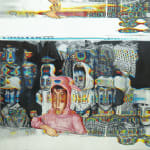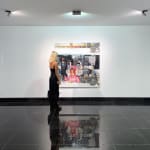

Javier Erre Zamora, Spain, b. 1981
Verbena, 2022
Oil on linen
150 x 150 cm
€5,400 + IVA
Javier Erre's work establishes a bridge between traditional painting and digital media, where the artist updates with great success the codes of contemporary figuration. Through a meticulously executed technique and...
Javier Erre's work establishes a bridge between traditional painting and digital media, where the artist updates with great success the codes of contemporary figuration. Through a meticulously executed technique and a detailed work process, images of elegant simplicity emerge. Using as a reference real photographs that have been intervened, the artist creates paintings in which
interesting alterations emulate the distortion caused by memory.
interesting alterations emulate the distortion caused by memory.
Exhibitions
Pink is not a colorLiterature
"Verbena" is a fundamental work in Javier Erre's recent pictorial production, and in particular of the series "Rosa no es un colour" in which, through the vicissitudes of a pink-rabbit-child, the artist addresses the question of memory: how it constructs our identity in the present and what we do with it.This piece is a very prominent example of the way Javier Errer works and of his explorations in painting where the artist manages to combine traditional technique with the imprint of digital media, in a superimposition of layers that also has a lot to do with memory.
In technical terms, there is a variation of grisaille (black and white paint that served as a dead layer or underpainting) on which layers of colour are applied by mass or glazes that partially reveal the layer underneath. This sometimes pure and vibrant chromaticism refers us to the separation of channels and brings out a great vitality in the black and white.
The painting begins with a memory or sensation that the artist wants to address. In this case, the sensation of the character's location/dislocation, the discovery of oneself and others. To construct this story he uses "real" memories. Javier looks for photographs that allow him to insert a fictional memory. In this case, it is a black and white photograph of a group of children dressed in regional costumes and football team caps that he found by chance in Madrid at the stalls of the Rastro.
From this memory, Erre constructs a new memory that emerges through digital techniques, photographic retouching and composition work, which will be the basis for the subsequent work of distortion. Thus, each new reading generates a new image.
The artist often leaves the signs of the process visible, which in this piece is perceived through misplacement. The image is not composed in the expected way, with the protagonists in the centre, but placed at the bottom, in the child's point of view. What is important remains below, forcing us to stop.
Join our mailing list
* denotes required fields
We will process the personal data you have supplied in accordance with our privacy policy (available on request). You can unsubscribe or change your preferences at any time by clicking the link in our emails.


